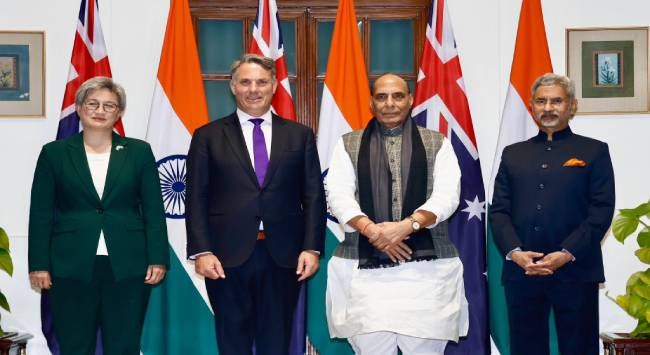Summary
Bilateral relations between India and Australia are being shaped by the evolving geopolitical and economic context in the Indo-Pacific. Defence, strategic and economic relations with India are increasingly important as Australia seeks to develop a strategic balance of power.
India and Australia affirmed their commitment to deepening strategic and economic relations during the second 2+2 Ministerial Dialogue, which was hosted in New Delhi on 20 November 2023. The meetings between Australian Foreign Minister Penny Wong and Defence Minister Richard Marles and their Indian counterparts, External Affairs Minister S Jaishankar and Defence Minister Rajnath Singh, occurred within, and were reflective of, the evolving geopolitical and geo-economic context – one in which India is seen as an important player in developing the strategic balance of power in the Indo-Pacific.
The intensifying competition between the United States (US) and China, and China’s maritime posturing in the Indo-Pacific have led Australia to undertake a major reassessment of its defence and strategic positioning in the Indo-Pacific. In April 2023, Australia unveiled its Defence Strategic Review (DSR). The stated aim of the DSR is to ensure that “Australia has the necessary capability to defend ourselves in the most complex strategic environment we have encountered as a nation in over 70 years.” Fundamentally, the DSR is framed on the premise that the US is no longer the unipolar leader of the Indo-Pacific region and that the future of the region will be shaped by “an emerging multipolar distribution of power“. Thus, Australia seeks to deepen relations with a number of regional powers like India and Japan to develop what Wong describes as a “strategic equilibrium”. Moreover, the DSR calls for a ‘whole of government’ approach in which trade, supply chains, the blue economy, technology and even the private sector are integrated parts of securing Australia’s national interests. Both factors foregrounded discussions on bilateral strategic relations, expanding trade relations and agreements over critical minerals at the 2+2 Ministerial Dialogue.
While India and Australia have long enjoyed good diplomatic relations, defence relations have been limited. However, concerns over China’s naval expansion and the need to secure supply chains have pushed both sides to relook their strategic relations. In 2020, bilateral relations were upgraded to the status of a Comprehensive Strategic Partnership (CSP). The CSP resulted in both sides expanding participation in joint-military exercises, developing mechanisms for information sharing and charting potential collaborations in science and technology. More broadly, the CSP also laid the basis for the development of converging visions of the Indo-Pacific. The 2+2 Ministerial Dialogue itself was established following the CSP as a forum to discuss strategic issues.
At the recent 2+2 Ministerial Dialogue, both sides also reaffirmed their commitment to accelerating discussions on the Comprehensive Economic Cooperation Agreement (CECA). The CECA is a free trade pact that was first mooted in 2010. While both sides agree that the pact will bring mutual benefits, negotiations have proven to be difficult and were suspended in 2016. The revived discussions on the CECA are focusing on a broad range of issues, including the agricultural sector, mining, critical minerals and space cooperation.
The commitment to finalising the CECA reflects both the growing trade relations between the two states and how trade is viewed as an integral part of national security. For context, India emerged as Australia’s ninth largest trading partner in 2022 and bilateral trade is expected to amount to US$70 billion (S$93.5 billion) by 2028. Particularly significant is the fact that Australia is an important source of coal and critical minerals for India. Approximately 74 per cent of India’s coal imports are from Australia. Thus, India is an important market for Australia. India’s importance may have been further accentuated by the fact that China imposed a two-year-long ban on coal imports from Australia. While China recently lifted this ban, Australian leaders likely remain concerned by the impact of such geopolitically motivated disruptions.
Furthermore, India will be an important market for Australia as it positions itself to be a major supplier of critical minerals. India’s future economy will require minerals like cobalt, titanium and lithium. China’s dominance in the global critical mineral supply chain has pushed India and Australia to develop converging strategies and agreements to ensure access to critical minerals. An example of this is the India-Australia Critical Minerals Partnership, which focuses on investment, extraction and processing of lithium and cobalt.
Overall, the evolving geopolitical and geo-economic landscape points to a deepening of relations between India and Australia. This is aided by the fact that the commitment to strengthening strategic relations cuts across party lines. In Australia, the foundations for the new strategic relationship were laid by the previous Liberal Party government. On its part, the current Labour government has sent a strong signal that it will build upon these. This is clear from the discussions at the 2+2 Ministerial Dialogue. Furthermore, while Prime Minister Anthony Albanese has sought to normalise relations with China, his government remains heavily invested in ensuring a “strategic balance of power” in the Indo-Pacific through stronger relations with countries like India.
. . . . .
Dr Iqbal Singh Sevea is Director of the Institute of South Asian Studies (ISAS), an autonomous research institute at the National University of Singapore (NUS). He can be contacted at isasiss@nus.edu.sg. The author bears full responsibility for the facts cited and opinions expressed in this paper.
Pic Credit: S Jaishankar’ Twitter Account
-
 More From :
More From :
-
 Tags :
Tags :
-
 Download PDF
Download PDF



